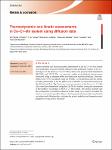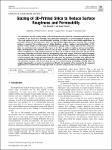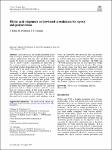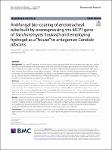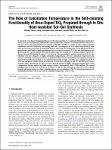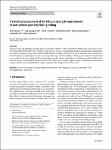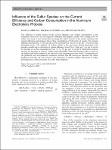Search
Author
- Osman, Ahmed I. (5)
- Daqing, Ma (3)
- Jorgensen, Ed (3)
- Li, Yan (3)
- next >
Subject
- kinh tế (26)
- Economics (12)
- programming (10)
- XRD (10)
- next >
Date issued
- 2020 - 2025 (2129)
- 2010 - 2019 (129)
- 2000 - 2009 (9)
- 1999 - 1999 (1)
Has File(s)
Search Results
Atomic mobility and thermodynamic assessments of the fcc Co–Cr–Mn system were performed using the ternary diffusion data. Diffusion couples in the Co–rich region of the ternary fcc Co–Cr–Mn system were prepared and annealed at 900, 1050, and 1150 °C. The concentration profiles across the joint interface were measured using an electron probe microstructure analysis technique. The interdiffusivities were evaluated using the Whittle–Green method, and the atomic mobility parameters of the fcc phase were evaluated via numerical analysis of the diffusional flux. The thermodynamic parameters of the binary fcc Cr–Mn alloy were also determined using the CALPHAD method during the assessment of the mobility parameters in the Co–Cr–Mn system. The atomic mobility and thermodynamic descriptions o... |
The advantages that 3D printing brings to the development and production of customized structures make it suitable for use in the space industry, since spacecraft components are rarely produced in large series. This work explores the use of stereolithography printing of a silica resin for microfluidic applications, in particular small-scale microthrusters, where an impermeable high-temperature material with a smooth surface is required. The printing accuracy, firing shrinkage, surface roughness and permeability of 3D-printed ceramic samples were investigated. Furthermore, glazing of the ceramic material with a stoneware glaze was performed and evaluated with respect to its effect on surface roughness and gas permeability. Open microchannels with diameter down to 250 µm were obtained... |
Tool steels are well known to have superior strength and are claimed to have superior wear resistance than conventional steels in several scenarios. However, their behavior under slurry erosion conditions have been seldom studied. To this end, a set of tool steels, primarily from the CPM yV (y = 1, 3, 9, 10, 15) alloy family, was selected to understand the effect of hardness and vanadium carbide content on the slurry jet erosion (SJE) performance at different impingement angles. It was observed that the SJE resistance increases with the increase in the vanadium carbide volume fraction, but is independent of alloy hardness. |
Nowadays, most SERS platforms are based on plasmonic metals like silver and gold. The current scientific achievement is to construct SERS non-metallic platform with SERS activity not worse than in case of standard metallic platforms. The prominent combination of opto-electronic properties of TiN (titanium nitride) makes it a promising alternative plasmonic material for noble metals. So far, the TiN nanostructures are widely tested in catalysis, especially in photocatalysis. Despite the TiN potential in SERS sensing applications, there are still several fundamental issues preventing its wide practical application. In this work, the surface morphology of TiN layers was tuned from planar 2D to a high aspect ratio 1D nanorod-like structures by industrially scalable normal and glancing a... |
In recent years, the chemical industry is not only striving to produce the best possible products for various applications, but the new products should ideally be based on renewable resources. The ideal case of "cradle to cradle" is generally not achievable in the coatings industry, as maximizing product life and preventing product degradation in the environment is usually one of the main goals of the coatings industry. Therefore, if the coatings industry wants to act sustainably, its efforts should be focused on renewable raw materials. This paper presents a process that makes the renewable raw material phytic acid easily accessible for conventional epoxy and polyol resin coating systems through hydrophobization- and oligomerization. |
For some ICU patients, an artificial airway must be established with an endotracheal tube, but Candida albicans can easily adhere to the tube surface and form a biofilm, leading to potentially life threatening fungal infections. Therefore, it is urgent to prevent and reduce C. albicans infections introduced by the endotracheal tube. However, there are few antifungal drugs effective against C. albicans, and each of these drugs may have adverse effects on human cells. Saccharomyces boulardii is regarded as an alternative strategy to inhibit the adhesion of C. albicans, but it is affected by environmental stress. We hypothesized that it is feasible to strengthen the antagonistic ability of S. boulardii via encapsulating and genetically modification. |
In this study, urea-doped titanium dioxide (urea-TiO2) nanoparticles were synthesized through an in situ heat-assisted sol–gel technique using titanium (IV) isopropoxide as the precursor for titanium dioxide and urea as a nitrogen source. The nanoparticles were calcined at 300, 500, and 700 °C to study the effect of the calcination temperature on their function as self-cleaning material. The nanoparticles were characterized using a scanning electron microscope and a transmission electron microscope for morphology, X-ray diffraction, Raman spectroscopy, and Fourier transformed infrared spectroscopy for structure, UV–Vis, and photoluminescence spectroscopy for optical analysis. The self-cleaning study was carried out by letting samples degrade methylene blue and Rhodamine-B under UV i... |
A statistical assessment of the fatigue strength improvement of butt-welded joints by flush grinding All major rules and guidelines include fatigue design (FAT) classes for flush ground butt-welded joints. These FAT classes vary between FAT110 and FAT155; however, in the majority of cases, the underlying database and specimen-related details are unclear or unknown. This study evaluates 1003 fatigue test results gathered from various literature sources and tries to relate the fatigue strength improvement to typical specimen types and test conditions. To this goal, statistical methods based on correlation analysis are employed. Next, proposals for updates of rules and guidelines for flush ground butt-welded joints made of steel are established by determining new FAT classes and a suitable slope exponent. In addition, an overview of design standards and recommendations is given and ma... |
Model alloys, Fe–20Cr and Fe–20Cr–20Ni (wt%) with and without 1% Si, were exposed to four different gas mixtures Ar–10H2O, Ar–10H2O–0.1HCl, Ar–10H2O–0.1HCl–10CO2, Ar–10H2O–0.1HCl–10CO2–0.5SO2 (vol.%) at 650 °C. The Fe–20Cr and Fe–20Cr–20Ni alloys underwent breakaway corrosion in Ar–10H2O–(0.1HCl)–(10CO2), forming Cr2O3 and Fe-rich oxide nodules. Silicon addition markedly increased corrosion resistance for both alloys by forming an additional SiO2 layer beneath the Cr2O3 scale. Addition of SO2 to Ar–10H2O–0.1HCl–10CO2 significantly suppressed the formation of Fe-rich oxide nodules on Fe–20Cr. Corrosion in the SO2-bearing gas resulted in (Cr, Fe, S)-rich precipitates in all alloys. The effects of gas composition and Si alloying on corrosion of both alloys are discussed in terms of tra... |
The influence of sulfur species on the current efficiency and carbon consumption in the aluminum electrolysis was investigated. Prebaked and graphite anodes with varying levels of sulfur were used. It was found that increasing the sulfur content in the anodes decreases the current efficiency and increases the carbon consumption of both types of anodes. The current efficiency decreased by 1.3 pct and the carbon consumption rose by 6.1 pct per 1 wt pct S in the prebaked anodes. The addition of sodium sulfate to the electrolyte during electrolysis with graphite anodes led to a decrease in current efficiency from 0.9 to 1.0 pct per 1 wt pct S, and to an increase in carbon consumption from 3.1 to 7.0 pct per 1 wt pct S. Electrolyte analysis showed the presence of sulfates, sulfides and p... |

